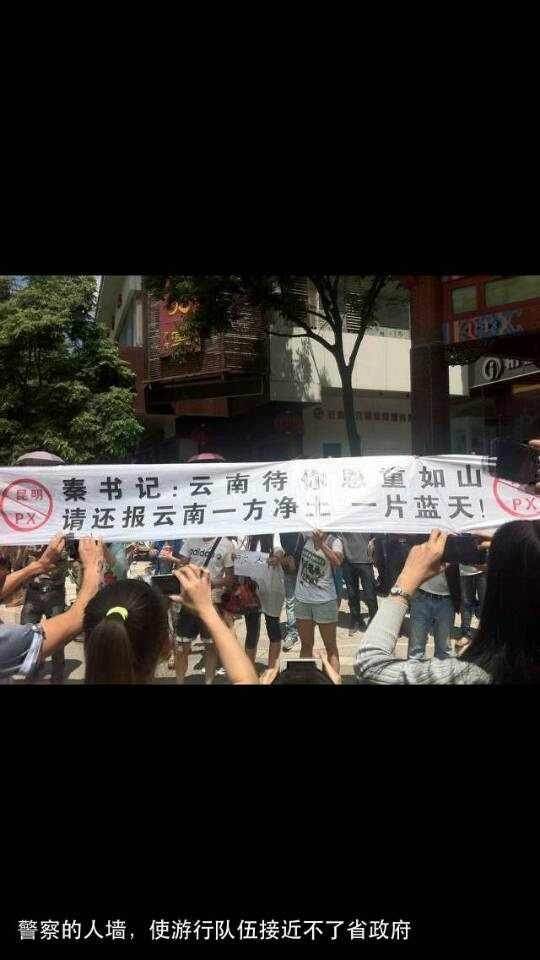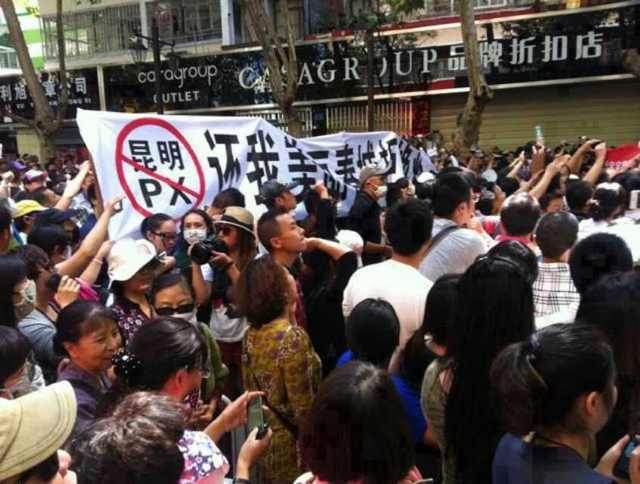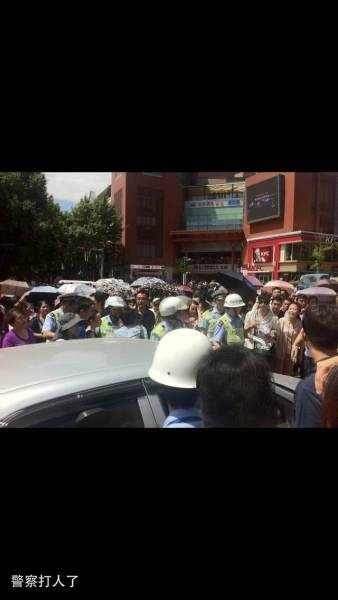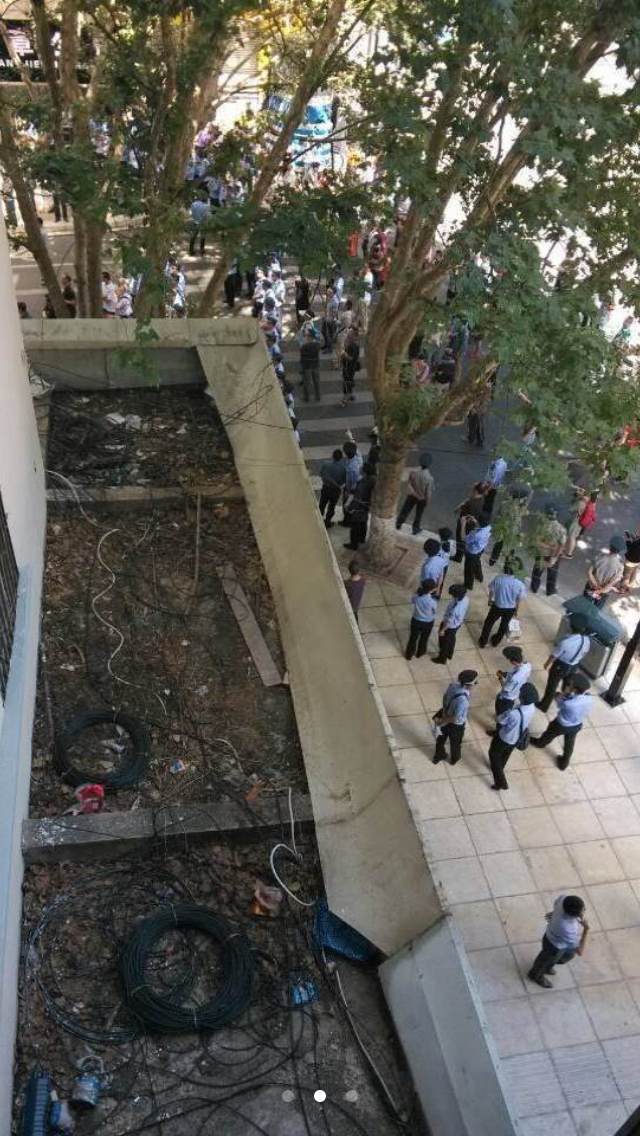Thousands of protesters rallied in Kunming on Thursday to oppose the construction of an oil refinery operated by China National Petroleum Corp. (PetroChina). The protests, the second this month, were mostly peaceful but were met with a heavy police presence, and a few scuffles and arrests were reported. From the Los Angeles Times:
The protest crowds Thursday were estimated to number as many as 2,500. Scores of uniformed and riot police looked on and sometimes scuffled with demonstrators, according to photos taken at the scene and comments posted on China’s social media. The rally was mostly peaceful but did not disperse until early evening, shortly after the mayor appeared and addressed the protesters.
Kunming officials have said that the refinery project by the state-owned giant China National Petroleum Corp. will meet environmental standards, but the city and company have refused to make public the environmental impact report.
Residents fear that the plant will pollute the area’s air and water, as well as produce large amounts of paraxylene, a carcinogenic chemical.
The march in Kunming, capital of Yunnan province, is the latest in a string of protests in China over worries about the environmental and health costs of development. [Source]
The lack of transparent information about the project has been a primary complaint of protesters. Officials have stated that paraxylene (PX) will not be used at the refinery, but protesters are distrustful of the government without seeing the environmental impact report. Domestic media has also been ordered not to conduct independent reporting on the project, according to a recent directive from the Central Propaganda Department. From CNN:
Several days after a May 4 protest, the Kunming mayor joined executives from the state China National Petroleum Corp. and the Yuntianhua Group for a joint news conference.
“The government will call off the project if most of our citizens say no to it,” said Mayor Li Wenrong, according to Xinhua.
The provincial general manager of China National Petroleum Corp. has said the refinery will not use the chemical.
“The project has no PX facilities, nor will it produce PX products,” Hu Jingke said, according to Xinhua.
Kunming residents expressed deep distrust of government officials and the state-owned enterprises behind the refinery project. [Source]
Al Jazeera reports on the skepticism many protesters feel toward the government’s claim:
Government officials said earlier in the week that the project, being built by the powerful state company PetroChina, would meet environmental standards and was crucial to the local economy.
However, local people remain worried that the refinery, which is expected to produce up to 10 million tonnes of refined oil annually, will pollute the air and water.
[…] He Bo, a deputy with the city government, appeared at the scene and tried to reach out to protesters, inviting them for a discussion with the government.
But the official, who was followed by state media cameras, failed to find representatives of the demonstrators who were willing to talk.
He finally gave up and abandoned the scene, escorted by security agents. [Source]
The refinery is being built largely to process oil transported through a new pipeline running from Myanmar to Yunnan. These protests fit a pattern of recent citizen actions against potential pollution from large-scale industrial projects in Chinese cities. Large protests have erupted against chemical processing facilities in Dalian, Xiamen, and Shifang, Sichuan, to name just a few. In the recent issue of Dissent Magazine, Jeffrey Wasserstrom interviews Duke University anthropologist Ralph Litzinger about the upsurge in environmental activism in China in recent years and specifically about the protests in Kunming on May 4 over the planned oil refinery:
JW: One of the most recent—maybe the most recent—NIMBY protest was in Kunming, a city I know you spent a lot of time in and that I remember from my one visit there in 1987 as an unusually beautiful and slow-paced place. I realize I’ll be in a shock if I return there, since I’ve heard it has grown exponentially in recent years and no longer has the same feel of being largely untouched by the harsher aspects of urban life. What’s your take on how the city’s changed and how this recent protests fits into the picture?
RL: Kunming is indeed a place very close to my heart. I first visited Kunming in 1990. As with many cities in China, the changes there are astonishing. Frankly, some of the development has been, to my mind, misguided, if only because Kunming now looks and feels like just another generic city on development steroids. Satellite cities are popping up all around Kunming, and many of these are sites for planned chemical factories, petrochemical plants, and other industrial manufacturing operations. On the one hand, we can argue that the protests in Kunming, meant to coincide with the May Fourth anniversary (one of the most hallowed days on the Chinese political calendar, commemorating as it does a patriotic 1919 Beijing demonstration that launched a nation-wide mass movement), are evidence of a growing consciousness, seen in other cities, about industrial pollution, chemical runoff into watersheds and rivers, and the environmental and health effects of tin and copper and other heavy mental mining. [Source]
The protests are galvanized by social media, where residents share information and protest plans. Photos and reports of the protest also spread in real-time via weibo and Twitter. A CDT reader and Kunming native sent us the following photos, which she received from friends in Kunming via WeChat (Weixin). Protesters are increasingly sharing information on the WeChat cell phone messaging application to avoid the censorship on weibo and in the media:
Read more about environmental activism, including anti-PX protests in Dalian and Xiamen, via CDT.












